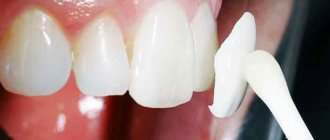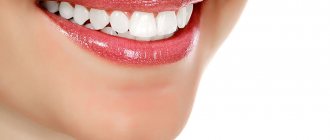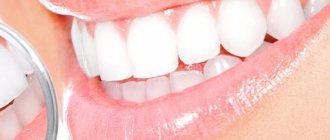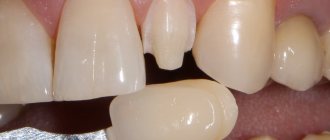The essence of the method
The peculiarity of restorative whitening is that the method allows you to give your teeth not only the desired shade, but also correct minor flaws (chips, cracks, stains, gaps between teeth). Please note that restoration methods do not affect the original color of the patient’s enamel and do not contribute to the destruction of unsightly pigment, as classical methods do, namely, they hide the defect. In this case, the patient has the opportunity to choose the color and degree of whiteness of the enamel, that is, he receives a predictable result, which is usually difficult to achieve with traditional lightening methods.
It is impossible to whiten chips and cracks in enamel using the usual method.
The purpose of restorative whitening is to improve the appearance and even correct the shape of row elements located in the smile area. The procedure is not carried out in the chewing area, since the materials used for it are not designed to withstand heavy loads.
The essence of the procedure for restorative teeth whitening comes down to the fact that the doctor applies artificial material to the frontal (front) surface of hard tissues or glues thin but very durable overlays that exactly imitate the color and shine of natural enamel. If the patient wishes, the specialist will always be able to remove, refresh or adjust the restorations, or select a new color.
Benefits of deep fluoridation
According to the professional technique for restoring tooth enamel, Aesculapius dentists use an active substance based on magnesium fluoride silicate. Immediately after the procedure, increased sensitivity caused by thinning of the enamel disappears. Specialists apply the active viscous substance exclusively with a swab or brush. Deep fluoridation is also carried out on crowns. The calcium level remains the same. Deep fluoridation is good because it eliminates early stage caries. At home it is impossible to achieve such a magnificent effect as in the clinic.
Indications for the procedure
- inability to achieve the desired effect using classical methods of enamel lightening: for example, if the patient has stains caused by severe forms of fluorosis and hypoplasia, yellow “tetracycline” teeth,
- sensitivity and increased abrasion of hard tissues: restorative bleaching performs not only an aesthetic, but also a protective function,
- in addition to the unsightly shade, the patient needs to eliminate a number of other defects: restore the anatomical shape of a chipped tooth, hide interdental gaps and cracks, hide old fillings, correct the position and shape of a crooked unit,
- age up to 18 years: some methods of restorative bleaching (for example, using composite materials) are suitable for young patients who are not yet allowed to use traditional methods of enamel lightening.
Indications for the use of the method are chips and defects of the teeth.
Restorative bleaching is not suitable for those who have severely damaged crown parts of the teeth and have periodontal diseases, leading to loosening and displacement of the roots. The procedures are also contraindicated in patients with serious occlusion pathologies. In these cases, doctors recommend other ways to solve the problem: prosthetics with crowns, treatment with braces and other orthodontic devices (alignments, trainers, arches, plates).
Price
The price of fluoridation of teeth varies within 1500 rubles. For the jaw. Our doctors will announce the final cost after completing a free consultation. Upon examination, the feasibility of fluoridation becomes clear. The doctor needs to be told about chronic diseases; for example, fluoridation is contraindicated for some patients with diabetes. Sign up for a consultation now on the website.
“Aesculapius” has permanent promotions:
- Crowns made of zirconium dioxide at a price of 9990 rubles.
- Discount on surgical and therapeutic treatment on weekdays from 12 to 16.
- Favorable implantation “day to day” (-10% of the price in the price list).
- Aligners for correcting bites - from 30 thousand rubles.
Methods for carrying out the procedure in a dental office
Restorative teeth whitening can be performed in several ways. Let's list them.
Direct method, when the doctor corrects defects directly in the patient’s mouth
In this case, restorative bleaching is carried out in just one visit to the clinic. In the process, the specialist removes plaque and grinds down the enamel a little (to level the surface and better adhesion of fabrics to artificial materials), and then applies layer-by-layer layers of composite (there can be 10 or more of them), which are then polymerized with a special lamp. The doctor achieves the required shade, forms the desired shape, position and size of the crown, and then carefully grinds and polishes the material.
The photo shows artistic restoration of teeth using composites.
This method appeals to a large number of patients, as it does not require serious financial investments. Moreover, the result of such restorative bleaching can be corrected at any time. But the direct method also has certain disadvantages:
- it is necessary that such exquisite work be performed by a professional doctor, otherwise you may be disappointed in the result obtained,
- The composite material is stained by food and drinks, and plaque deposits on it. In addition, the composite does not have the shine of natural enamel, so over time it becomes dull and needs to be polished. To maintain the restoration in good condition, you need to visit the dentist at least once every 3-4 months.
“I really hoped to whiten my front teeth, because there are dark spots on them, but the doctor categorically forbade it. He said that the spots are caused by a disease, and bleaching not only will not help me, but will further deteriorate the condition of the enamel, making it thinner and more sensitive. I was very upset and was going to get crowns, but the specialist suggested a less radical and more affordable measure, namely restorative bleaching with a composite. Without thinking twice, she agreed. Yes, the method has disadvantages, but it’s better than walking around with spots like mine. I can say that it’s definitely worth doing the procedure if you have a similar hopeless situation.”
Karine, review from otzovik.com
Indirect method, when the restoration is pre-created in the laboratory
In this case, it will not be possible to get by with just one visit to the doctor.
At the first stage, the specialist prepares the teeth that need restorative bleaching and takes impressions of the jaws. During the preparation process, it is necessary to cut down the enamel layer (usually 0.3 to 0.8 mm of tissue is removed, which depends on the thickness of the onlay chosen by the patient). During the production of restorations, the doctor covers the prepared tissues with caps that protect them from destruction, bacteria, temperature and hardness of food.
At the initial stage, dental impressions should be taken
At the second stage, the resulting impressions are sent to the laboratory, where technicians create thin onlays from materials such as composite, ceramic, ceramic composite, and zirconium dioxide. The waiting process for restoration overlays usually takes about 2-3 weeks.
Direct restorative teeth whitening is usually carried out by a dentist-therapist, but indirect restorations are carried out by an orthopedic surgeon.
At the third stage, in fact, restorative bleaching takes place, but in this case it would be more correct to call it microprosthetics. The specialist processes, disinfects and thoroughly dries hard tissues, after which he places the thinnest snow-white overlays on their surface, which are securely and permanently fixed with dental cement.
Installing veneers will help change the color, shape and size of teeth
Among the advantages of this method: durability (7-15 years or more), high level of aesthetics, preservation of the original color of the restoration throughout its entire service life, resistance to dyes from food and drinks, protection of sensitive enamel from bacteria, caries and destructive processes. But there is one significant drawback - the high price.
The feasibility of fluoridation on children's teeth
Aesculapius dentists offer parents of young patients to use this service if necessary. Baby teeth especially need protection. Deep fluoridation of teeth does not cause tears in children. For young patients, the procedure does not pose any danger; as a result of the restoration measures, an extremely positive effect is observed. Fluoridation on children's teeth is no different in technology from the technique according to which the enamel of adults is strengthened.
Doctors suggest young and adult patients use the service, as mentioned earlier, every 1-1.5 years. If treatment is necessary before fluoridation, it is wise not to ignore your dentist's recommendations. After the procedure, the doctor must tell the child and parents about the rules of oral care. Following the “instructions” is extremely important! It is necessary not only to regularly brush your teeth with high-quality toothpastes, but also to eat properly to avoid fluoride deficiency. The body will benefit from taking multivitamin complexes. Deep fluoridation of baby teeth with caries is the most correct professional way to protect the enamel from further destruction.
Standard whitening and restoration methods: what's the difference?
Dentists carry out laser, chemical, lamp and cosmetic whitening, where hydrogen or carbamide peroxide in different concentrations is used as the main active ingredient that corrodes the color pigment. But there are patients for whom the service is not suitable due to contraindications, and for them an excellent alternative is restorative teeth whitening, which allows not only to hide unsightly shades and stains, but also to correct a number of other minor defects (chips, cracks, slight curvature and tilt of teeth , cracks).
The main differences between classic and restorative bleaching are presented in the table below.
| Classic methods | Restoration | |
| Mechanism of action | The enamel brightens by 5-12 tones (depending on the method) under the influence of a gel with peroxide applied to the teeth and activated in various ways (lamp light, chemical components, laser) | The teeth are covered with a thin layer of composite and other materials, which the doctor skillfully applies or glues to the surface of the enamel, resulting in a snow-white smile |
| Possibilities | Changing the shade of enamel, removing persistent stubborn pigment from food and after smoking. The ability to remove stains from mild forms of fluorosis and hypoplasia | Comprehensive concealment of all minor defects: stains, chips, cracks, curvature. Getting not only the desired color, but also correcting the shape and position of the tooth |
| Contraindications | Thin and sensitive enamel, multiple caries, wedge-shaped defect and erosion, severe forms of non-carious lesions | Suitable for patients for whom traditional enamel lightening methods are contraindicated |
| Preparation for the procedure | It is important to treat tooth decay and other dental diseases. It is necessary to clean the fabrics from soft and hard deposits in order to obtain an even lightening effect. Also, the enamel is pre-strengthened with fluoride or remineralizing compounds with calcium | Traditionally, diseased teeth are treated, plaque is removed, and tissue is fluoridated. Before applying materials or installing onlays, be sure to grind off a small layer of enamel so that the smile looks natural |
| Condition of teeth after the procedure | Immediately after the procedures, tissue sensitivity increases. There is a reaction to cold, hard and hot foods | A layer of restoration materials protects hard tissues from any external influence |
| Durability | 2-4 years, provided that the patient diligently maintains the result, follows a “white” diet, carefully carries out oral hygiene, and gives up smoking | A smile can maintain its beauty for 5-10 years or more. However, some artificial materials cannot be stained by food. |
| Price | From 8,000 to 30,000 rubles for both rows of front teeth. The most inexpensive method is chemical. Expensive – laser and lamp technologies (for example, ZOOM). |
|
Fluoridation of teeth: effective rapid restoration of enamel
White, strong teeth are self-confidence, the dream of many Moscow residents! To have a beautiful and radiant smile, you need to take proper care of your oral cavity and regularly visit the dentist’s office. Improper brushing of teeth leads to the appearance of defects in the enamel. Is it possible to get rid of existing problems? Of course, dentistry keeps up with the times. To restore the integrity and beauty of the enamel, our dentists perform fluoridation of teeth; the price of the service starts from 150 rubles per tooth. The procedure is painless and suitable for adults and small patients. We invite you to your first consultation, it is free!
Nuances you need to know before the procedure
It is often written on the Internet that restorative whitening is a non-invasive procedure during which the original structure and condition of the tooth are not disturbed, and the composite or onlays are simply glued to the patient’s enamel on top. But this statement is nothing more than a publicity stunt.
Imagine what the restoration will look like if you simply glue an artificial material on top of your teeth, which also has some thickness? Let's list the consequences:
- the tooth made will protrude forward and stand out from the rest, it will increase in volume,
- without preparing hard tissues, it will not be possible to hide existing defects, stains, irregular shape and curvature of the crown,
- the area at the border of the material with the mucous membrane, if you do not make a smooth transition or ledge, will generally look unnatural, will become constantly injured and inflamed, since food debris and bacterial plaque will constantly clog into the resulting gap.
Before installing microprostheses, the specialist grinds the teeth.
Before carrying out restorative bleaching, the doctor carries out, albeit minor, grinding of hard tissues from the vestibular (anterior), cervical and lateral sides. This procedure is also necessary to level the relief and surface of the tooth and ensure a tight fit of the materials, as well as their high-quality and durable fixation. Only patients who choose original lumineers1 can avoid preparation - in this case, the doctor only slightly grinds the enamel and treats it with glue before installing the onlays.
Notice
: Undefined variable: post_id in
/home/c/ch75405/public_html/wp-content/themes/UltraSmile/single-item.php
on line
45 Notice
: Undefined variable: full in
/home/c/ch75405/public_html/wp-content /themes/UltraSmile/single-item.php
on line
46
Rate this article:
( 2 ratings, average: 5.00 out of 5)
whitening
- Fleisher G.M. Lumineers - a new alternative to teeth whitening // Review. Dentistry. – 2014.
FAQ
– What is dental fluoridation?
Fluoridation is the saturation of hard tooth tissues with fluoride compounds by applying various liquids to the enamel. The procedure has proven its effectiveness both when performed on baby teeth and in permanent dentition.
– Is there any harm from the procedures?
Fluoridation is completely harmless if the doctor follows all the manufacturer's instructions. Using a saliva ejector removes excess saliva and prevents solutions from being swallowed. At home, you should not use preparations for professional use, because it is impossible to ensure high-quality isolation of the mucous membranes from fluoride varnish or fluoride-containing gel.
Comments
Is it possible to immediately do restoration after regular whitening if you are not satisfied with the result?
Svetlana (02.10.2020 at 22:54) Reply to comment
- To eliminate serious color pigmentation, spots, as well as to correct other defects, doctors often combine methods of classical and restorative bleaching. If this is indicated, the classic enamel lightening is first carried out, after which the teeth are given time to recover and strengthen, and after 2-4 weeks restorations are performed.
Editorial staff of the portal UltraSmile.ru (05.10.2020 at 09:14) Reply to comment










